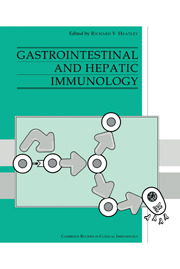Book contents
- Frontmatter
- Contents
- List of contributors
- Preface
- 1 Lymphoid cells and tissues of the gastrointestinal tract
- 2 Lymphocyte migration to the gut mucosa
- 3 Regulating factors affecting gut mucosal defence
- 4 Gastritis
- 5 The immunology of coeliac disease
- 6 Inflammatory bowel disease
- 7 Food intolerance and allergy
- 8 Gastrointestinal and liver involvement in primary immunodeficiency
- 9 Secondary immunodeficiency – the acquired immunodeficiency syndrome (AIDS)
- 10 Intestinal infections
- 11 Lymphomas
- 12 Small bowel transplantation
- 13 Clinical aspects of immunologically mediated intestinal diseases
- 14 Chronic active hepatitis
- 15 Primary biliary cirrhosis
- 16 Immunology and immunopathology of acute viral hepatitis
- 17 Immunology of liver transplantation
- 18 Clinical correlates with hepatic diseases
- Index
4 - Gastritis
Published online by Cambridge University Press: 03 February 2010
- Frontmatter
- Contents
- List of contributors
- Preface
- 1 Lymphoid cells and tissues of the gastrointestinal tract
- 2 Lymphocyte migration to the gut mucosa
- 3 Regulating factors affecting gut mucosal defence
- 4 Gastritis
- 5 The immunology of coeliac disease
- 6 Inflammatory bowel disease
- 7 Food intolerance and allergy
- 8 Gastrointestinal and liver involvement in primary immunodeficiency
- 9 Secondary immunodeficiency – the acquired immunodeficiency syndrome (AIDS)
- 10 Intestinal infections
- 11 Lymphomas
- 12 Small bowel transplantation
- 13 Clinical aspects of immunologically mediated intestinal diseases
- 14 Chronic active hepatitis
- 15 Primary biliary cirrhosis
- 16 Immunology and immunopathology of acute viral hepatitis
- 17 Immunology of liver transplantation
- 18 Clinical correlates with hepatic diseases
- Index
Summary
Introduction
Normal gastric mucosa contains few, if any, inflammatory cells. Gastritis represents the inflammatory response within the gastric mucosa resulting from injury, whatsoever the nature. The diagnosis is essentially histological since naked eye appearances are known to be unreliable. The advent of fibre-optic endoscopy and biopsy has considerably increased our knowledge about this condition and its natural history (Heatley & Wyatt, 1994). On a worldwide basis, gastritis is extremely common. Various classifications of gastric inflammation have developed based upon current knowledge at the time but, more recently, existing systems have been swept aside by the current terminology based upon known pathogenic mechanisms (Misiewicz, 1991). Most cases of gastritis are now known to be caused by infection with Helicobacter pylori. Other causes, including auto-immune gastritis, probably represent less than 10% of all cases of gastritis in most populations (Heatley & Wyatt, 1994).
Acute gastritis
The histological changes observed are usually simply those associated with acute inflammation, namely hyperaemia, infiltration with polymorphonuclear cells and oedema, together with a variable loss of surface epithelium. Macroscopically, oedema, small superficial haemorrhages and erosions or small ulcers may be visible (Heatley & Wyatt, 1994). A range of external influences have been shown to produce these changes but amongst the most important are alcohol excess, some spices, non-steroidal anti-inflammatory drugs (NSAIDs) including aspirin and metabolic disturbances associated with acute illnesses, in particular uraemia. Salicylate ingestion is one of the most studied models of acute injury.
- Type
- Chapter
- Information
- Gastrointestinal and Hepatic Immunology , pp. 76 - 94Publisher: Cambridge University PressPrint publication year: 1994

